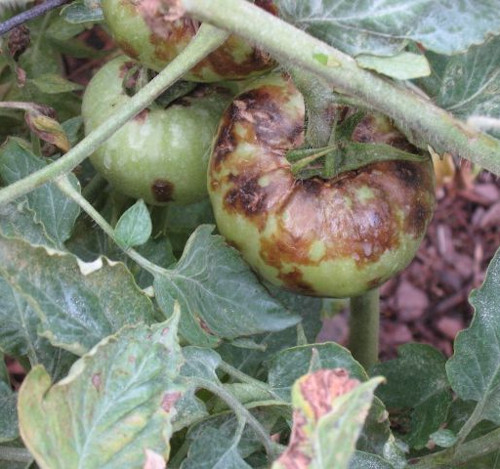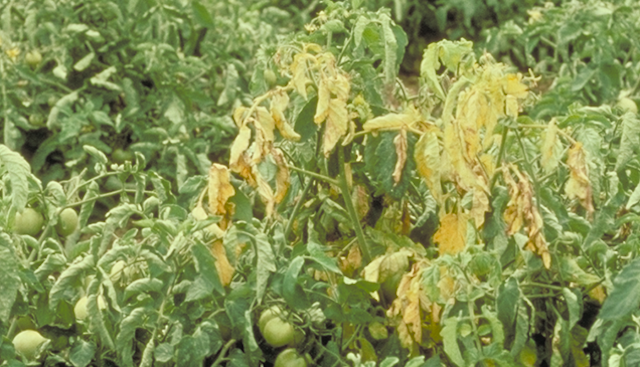Tomatoes are one of the most popular vegetables (fruit) grown in India, providing essential nutrients like vitamin C, K, and fiber. However, like any other plant, tomatoes are prone to diseases that can cause significant damage to the plant, affecting the yield and quality of the fruit. Therefore, it is essential to identify the most common tomato diseases in India and how to manage them effectively.

Early Blight: Early blight is one of the most common tomato diseases in India. It is caused by the fungus Alternaria solani and can cause significant damage to the plant, leading to leaf yellowing, leaf drop, and reduced fruit yield. The disease can be identified by the appearance of small, dark spots on the lower leaves that gradually enlarge and turn yellow.
Management: Early blight can be managed by planting disease-resistant tomato varieties, maintaining proper plant spacing, and practicing good sanitation practices such as removing infected plant debris. Fungicides containing chlorothalonil can also be used to manage the disease.

Late Blight: Late blight is another common tomato disease in India. It is caused by the fungus Phytophthora infestans and can cause significant damage to the plant, leading to brownish-black lesions on the leaves, stem, and fruit.
Management: Late blight can be managed by planting disease-resistant tomato varieties, avoiding overhead irrigation, and maintaining proper plant spacing. Copper-based fungicides can also be used to manage the disease.

Bacterial Spot: Bacterial spot is a bacterial disease that affects tomato plants in India. It is caused by the bacterium Xanthomonas campestris and can cause small, water-soaked spots on the leaves that eventually turn brown and coalesce.
Management: Bacterial spot can be managed by planting disease-resistant tomato varieties, avoiding overhead irrigation, and practicing good sanitation practices such as removing infected plant debris. Copper-based fungicides can also be used to manage the disease.
Fusarium Wilt: Fusarium wilt is a fungal disease that affects tomato plants in India. It is caused by the fungus Fusarium oxysporum and can cause yellowing of the leaves, wilting, and death of the plant.

Management: Fusarium wilt can be managed by planting disease-resistant tomato varieties, avoiding overhead irrigation, and practicing good sanitation practices such as removing infected plant debris. Fungicides containing azoxystrobin can also be used to manage the disease.
Verticillium Wilt: Verticillium wilt is a fungal disease that affects tomato plants in India. It is caused by the fungus Verticillium dahliae and can cause yellowing of the leaves, wilting, and death of the plant.

Management: Verticillium wilt can be managed by planting disease-resistant tomato varieties, avoiding overhead irrigation, and practicing good sanitation practices such as removing infected plant debris. Fungicides containing azoxystrobin can also be used to manage the disease.
Here is an exhaustive list of common tomato diseases in summers in India:
- Bacterial Wilt
- Early Blight
- Late Blight
- Leaf Spot
- Powdery Mildew
- Anthracnose
- Bacterial Spot
- Bacterial Canker
- Verticillium Wilt
- Fusarium Wilt
- Root Rot
- Nematodes
- Tomato Yellow Leaf Curl Virus (TYLCV)
- Tomato Mosaic Virus
- Tomato Spotted Wilt Virus (TSWV)
- Fusarium Crown and Root Rot
- Grey Mold
- Botrytis Blight
- Phytophthora Blight
- Fusarium Crown and Stem Rot
- Pythium Root Rot
- Septoria Leaf Spot
- Tomato Fruit Rot
- Corky Root Rot
- Tomato Pith Necrosis Virus
- Tomato Ringspot Virus
- Tomato Bushy Stunt Virus
- Tomato Streak Virus
- Tobacco Etch Virus
- Tobacco Mosaic Virus
Conclusion:
Tomatoes are a valuable crop in India, and managing diseases is crucial to ensure a healthy yield. Early detection and management of the common tomato diseases in India are crucial to minimize damage to the plants and reduce yield losses. Proper cultural practices such as planting disease-resistant tomato varieties, maintaining proper plant spacing, and good sanitation practices can help prevent the spread of diseases. Fungicides containing appropriate active ingredients can also be used to manage diseases in tomato plants.
